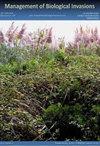两种载体中抗霉素A对草鱼、青鱼的摄食毒性研究
IF 1.2
4区 环境科学与生态学
Q3 BIODIVERSITY CONSERVATION
引用次数: 2
摘要
毒饵是一种潜在的控制有害鲤鱼的机制,但鱼藤素对草鱼的毒饵效果不佳。失败的原因是鱼藤酮的适口性,因为在提供杀鱼诱饵之前,无害的训练颗粒很容易被消耗掉。一些研究表明,抗霉素A是一种常见的替代杀鱼剂,通常直接施用于水中,可能适合作为摄入的诱饵。抗霉素A的口服毒性尚未得到很好的描述。我们评估了两种载体(乙醇和玉米油)中抗霉素A对草鱼和青鱼灌胃的毒性。剂量范围为1 - 16mg /kg。计算了50%处理鱼的致死剂量估计值(LD50),并在处理后24小时和96小时报告了观察到的导致完全死亡的处理水平。乙醇是比玉米油更有效的载体,具有较低的LD50估计和观察到的完全死亡率处理水平。玉米油中的抗霉素A即使在处理96小时后,在给予最高剂量时,也只造成黑鱼的部分死亡。结果记录了草鱼和黑鱼死亡所需的摄入剂量,可用于将来开发物种选择性抗霉素A诱饵。本文章由计算机程序翻译,如有差异,请以英文原文为准。
Ingested toxicity of antimycin A to grass carp Ctenopharyngodon idella and black carp Mylopharyngodon piceus in two carriers
Toxic baits are a potential control mechanism for nuisance carps, but rotenone-based baits for grass carp Ctenopharyngodon idella have been ineffective. Failures have been attributed to the palatability of rotenone because innocuous training pellets are readily consumed prior to provision of piscicide baits. Several studies suggest antimycin A, a common alternative piscicide, typically applied directly to water, may be suitable as an ingested bait. The oral toxicity of antimycin A is not well described. We evaluated the oral toxicity of antimycin A in two carriers (ethanol and corn oil) on grass carp and black carp Mylopharyngodon piceus, administered via gavage. Doses ranged from 1–16 mg/kg. Lethal dose estimates for 50% of treated fish (LD50) were calculated, and the observed treatment levels resulting in complete mortality are reported at 24- and 96-hours post-treatment. Ethanol was a more effective carrier than corn oil with lower LD50 estimates and observed treatment levels with complete mortality. Antimycin A in corn oil produced only partial mortality of black carp even 96 hours from treatment and at the highest dose administered. Results document ingested doses required for mortality of grass carp and black carp that may be used for future development of species-selective antimycin A baits.
求助全文
通过发布文献求助,成功后即可免费获取论文全文。
去求助
来源期刊

Management of Biological Invasions
Agricultural and Biological Sciences-Ecology, Evolution, Behavior and Systematics
CiteScore
3.40
自引率
6.70%
发文量
21
审稿时长
16 weeks
期刊介绍:
Management of Biological Invasions, established in 2010 by Dr. Elias Dana, is an open access, peer-reviewed international journal focusing on applied research in biological invasions in aquatic and terrestrial ecosystems from around the world. This journal is devoted to bridging the gap between scientific research and the use of science in decision-making, regulation and management in the area of invasive species introduction and biodiversity conservation.
Managing biological invasions is a crisis science, with Management of Biological Invasions aiming to provide insights to the issues, to document new forms of detection, measurements and analysis, and to document tangible solutions to this problem.
In addition to original research on applied issues, Management of Biological Invasions publishes technical reports on new management technologies of invasive species and also the proceedings of relevant international meetings. As a platform to encourage informed discussion on matters of national and international importance, we publish viewpoint papers that highlight emerging issues, showcase initiatives, and present opinions of leading researchers.
 求助内容:
求助内容: 应助结果提醒方式:
应助结果提醒方式:


